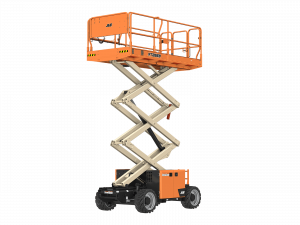Check Out Out JLG RT2669 Scissor Lifts!

| Power Source | |
| Engine Model | Kubota D1305-E4B-J |
| Engine Type – Diesel | 24.8 hp (18.5 kw) |
| Engine Type – Dual Fuel | Kubota WG972-GL-E4 (31 hp (23.2 kw) |
| Fuel Tank Capacity – Diesel | 10 gal. / 37.85 L |
| General | |
| Capacity – Hydraulic Reservoir | 13.2 gal. / 49.97 L |
| Machine Weight | 8250 lb / 3742.14 kg |
| Performance | |
| Drive Speed – Platform Elevated | 0.5 mph / 0.80 km/h |
| Drive Speed – Platform Lowered | 3.5 mph / 5.63 km/h |
| Gradeability – 2WD | 40 % |
| Lift Time | 32 sec. |
| Lower Time | 37 sec. |
| Platform Capacity | 1500 lb / 680.39 kg |
| Platform Capacity – Extension | 300 lb / 136.08 kg |
| Turning Radius – Outside | 14 ft 7 in. / 4.44 m |
| Dimensional Data | |
| Machine Height | 8 ft 1 in. / 2.46 m |
| Machine Length | 11 ft 7 in. / 3.53 m |
| Machine Width | 5 ft 9 in. / 1.76 m |
| Platform Dimension A | 10 ft 6 in. / 3.2 m |
| Platform Dimension B | 4 ft 9 in. / 1.45 m |
| Platform Extension Length | 3 ft 6 in. / 1.07 m |
| Platform Height – Lowered | 4 ft 3 in. / 1.3 m |
| Platform Railing Height | 3 ft 9 in. / 1.14 m |
| Tire Size | 26 x 12 Foam Filled |
| Wheelbase | 6 ft 9 in. / 2.07 m |
| Reach Specifications | |
| Platform Height | 26 ft 2 in. / 7.98 m |
| Working Height | 32 ft / 9.75 m |
These engine‑powered scissor lifts are made for outdoor and rugged job sites. They’re ideal for lifting crews, tools, and materials to heights up to around 26 ft on uneven ground. Their drive-at-height feature reduces trips up and down the platform, boosting productivity.
Depending on the model, JLG rough‑terrain scissor lifts can typically raise crews to 20–50 feet, making them useful for tasks like building maintenance, construction, and installation work.
JLG rough‑terrain scissor lifts have larger tires, stronger traction, and more powerful engines, allowing them to navigate dirt, gravel, and uneven ground — something indoor electric models aren’t built for.